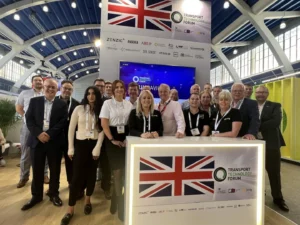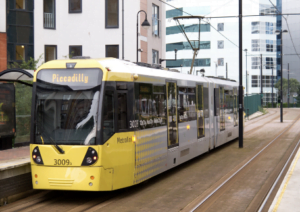As part of the Highways News Theme Week on Traffic Management, Vivacity Labs give an update on their programme to develop an AI-based traffic signals optimisation system.
More details about this project will be given at the JCT Traffic Signals Symposium in Nottingham, which takes place on 15 and 16 September. This is an excerpt from their paper.
Vivacity Labs, partnered with Transport for Greater Manchester (TfGM) and Immense Simulations for this Innovate UK co-funded project to build and trial a solution which uses AI to optimise traffic networks.
Along the way, we have presented our progress at the past two JCT conferences. Last year, we were excited to share that we had successfully deployed the system to three junctions in Greater Manchester. This year, we are rounding out this three-part series by sharing some of our key achievements of the past year, summarising our overall learnings, and discussing our further development and commercialisation plans.
Our results from real-world trials have proven that AI can be used to improve on existing systems by up to 30%. We are scaling up these demonstrations, and expect to quantify this more precisely and thoroughly in future, but these initial results are extremely promising.
Key Challenges:
For transport authorities today, congestion is only one of many different priorities. Improving air quality, prioritising active travel, and improving public transport reliability/uptake are all at the top of the agenda. SCOOT and MOVA have dominated traffic signal control in the UK for the last few decades, and while both have scenarios in which they work effectively, reducing congestion through coordination of multiple junctions (SCOOT) or optimising individual junctions (MOVA), they have both struggled optimising signal timings to improve air quality or to help other modes of transport.
Air quality optimisation with SCOOT has been trialled, but not rolled out at any scale. Bus priority in SCOOT, while well established, is a relatively blunt instrument, overriding optimisation for any other mode to provide late running buses with green signals, and thus degrading overall system performance. Meaningful prioritisation for other key modes, such as cyclists, is not widely available. Meanwhile, it is well known that performance of SCOOT degrades over time, often by up to 30% – but recalibration is manual and expensive and thus not viable for many authorities.
In this context, it is vital that transport authorities get access to better systems, which allow authorities to prioritise any objective according to their local policies.
System Overview
Our system is comprised of several key components:
- Vivacity’s sensors, which can detect and classify 9 different types of road user, providing accurate, real-time data
- A microsimulation model, using historic data from the sensors to achieve a very precise calibration
- Our optimisation algorithm, which uses cutting-edge AI based Reinforcement Learning, a branch of machine learning / artificial intelligence. This is trained in the microsimulation, to work out how best to perform in the real world, and then uses real-time data from the sensors in order to execute an optimal control strategy, adapting quickly to changing traffic conditions and optimising at both local and city-wide scale
Key Milestones over the past year Simultaneous Control of Five Junctions After independently controlling three neighbouring junctions last year, we scaled the system to control a whole key corridor on the main orbital route on the Manchester / Salford border.
These junctions had a range of different layouts, characteristics, and challenges; the stage diagrams for these can be seen below. We were able to achieve coordination along the corridor, with a single AI agent or algorithm, which had been trained on a large microsimulation of this region, making decisions for all 5 junctions (analogous to a SCOOT region):

Continuous, unsupervised control
In order to gather significant performance data and to allow us to scale more effectively, our next development target was to improve the robustness of the system to allow us to leave the control pipeline running for long periods of time without the need for constant, human monitoring. In order to achieve this we developed a set of alerts to notify the users (Vivacity internal team initially) about any system or performance issues. We tuned the alerting parameters to adjust the agent configuration and the alert thresholds and build confidence in the completeness of the alerts. The key outcome is that we are currently running unmonitored, A/B testing at one junction in Manchester, Trinity Way – Great Ducie Street(x47), controlling from 7am to 7pm, and adapting automatically to changes in demand level and turning proportions (i.e. no need to timetable plans as in incumbent systems).
Control Algorithm Improvements
Over the past year, we have carried out a detailed research programme to improve the operation of Reinforcement Learning for signal control, building on our work last year. Combining the latest academic research with innovations of our own, we have seen substantial improvements in underlying performance, with the latest results in simulation showing a 45% reduction in average vehicle waiting times across a 6-junction region when compared against vehicle actuated (VA) control or System D control.
Early results from continuous control have shown reduction in average journey times of 30% across key routes during control periods:

Smart Junctions – JCT 2021_final.docx
In early 2022, we will fully launch our first product for signal control, which takes our learning to date and is focused on congestion reduction. This system will make use of our camera sensors and provide our full, rich data to the system. This data will also be available to clients via the dashboard and API.
Clients will be able to monitor the junction(s) behaviour and performance through the Vivacity dashboard. The dashboard will include tools and panels to view real-time, low latency data on controller state, algorithm actions, and demand of each stage. Additionally, users will receive alerts on congestion incidents and will be able to use the camera sensors to validate and investigate incidents.
As well as real time monitoring and alerting capabilities, the dashboard will have enhanced data analysis tools to allow users to quantify performance of the system and compare journey times and dwell times of different control methods.
(All pictures courtesy of Vivacity Labs)





















